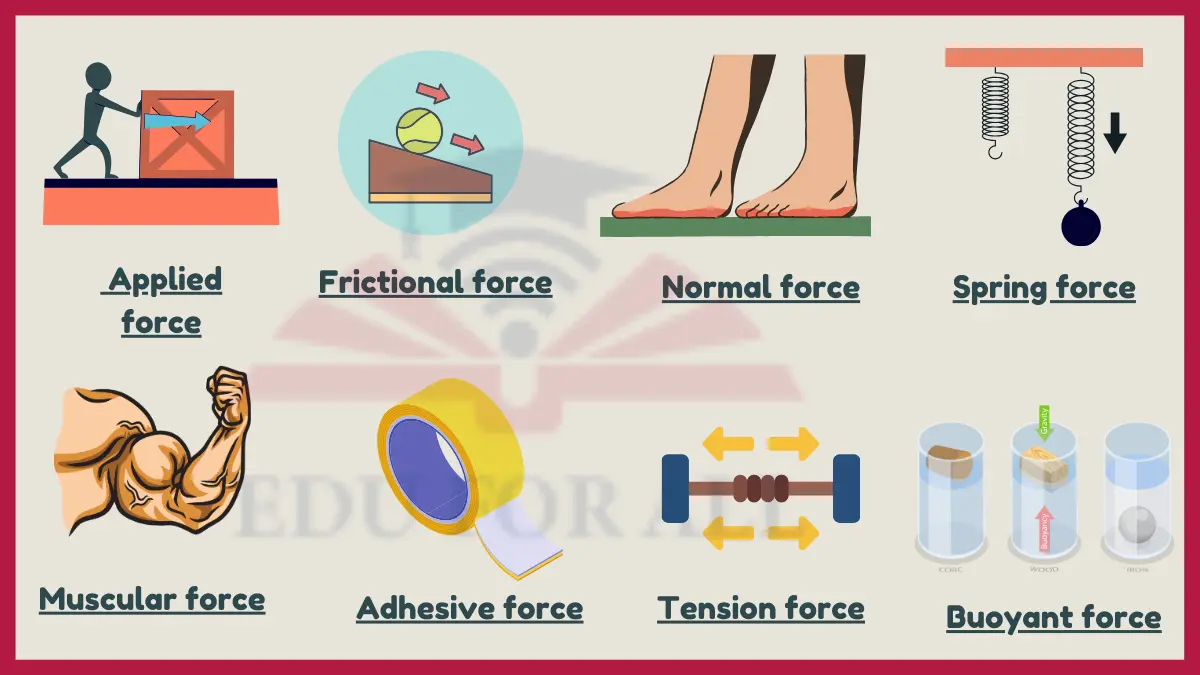Contact forces are forces that act between two objects when they are in physical contact. Applied force, frictional force, normal force, tension force, air resistance, spring force, and centripetal force are a few examples of contact forces.

Examples of Contact Forces
Here are 14 examples of contact forces:
1. Applied force
Applied force is an example of contact force because it arises from direct physical contact between two objects.
An applied force is a force that is exerted on an object by another object. For example, the force you apply to a door when you push it open is an applied force or when you push a book across a table.
2. Frictional force
The frictional force is a contact force that occurs when two surfaces slide against each other. It arises from direct contact between the surfaces.
The frictional force is an example of contact force that resists the motion of two objects in contact with each other. The frictional force is caused by the microscopic interactions between the surfaces of the two objects. For example, the friction between your shoes and the ground is what allows you to walk without slipping.
3. Normal force
Normal force is a contact force because it requires direct physical contact between two surfaces. Normal force is perpendicular to the contact surface between two objects. It prevents objects from passing through each other by arising from direct physical contact.
The normal force is responsible for preventing objects from sinking into each other. For example, the normal force between your feet and the ground is what prevents you from falling through the floor.
4. Tension force
Tension force is an example of contact force because it is transmitted through the contact of a string or cable. A tension force is a force that is transmitted through contact of a string or cable. Tension forces are always pulling forces. For example, the tension force in a rope is what allows you to lift a heavy object.
5. Air resistance
Air resistance is a contact force because it is caused by the interaction of an object with the air molecules around it.
Air resistance is a force that opposes the motion of an object through the air. Air resistance is caused by the interaction of the object with the air molecules. For example, air resistance is what slows down a baseball as it flies through the air.
6. Spring force
Spring force is a common example of contact force as it arises from contact between coils or particles within the spring as it is compressed or extended.
A spring force is a force that is exerted by a spring when it is compressed or stretched. Spring forces are always restoring forces, meaning that they always try to return the spring to its original shape. For example, the spring force in a trampoline is what allows you to bounce.
9. Buoyant force
The buoyant force is a contact force that acts on an object submerged in a fluid through direct contact with the fluid. As the object displaces the fluid, the surrounding fluid exerts an upward force on the object, counteracting the weight force and making it easier for the object to float.
The buoyant force is an upward force that acts on an object submerged in a fluid. The buoyant force is equal to the weight of the fluid displaced by the object. For example, the buoyant force is what allows boats to float.
10. Muscular force
Muscular force is a contact force because it is produced by the contraction of muscles, which are attached to bones. The bones then exert a force on the ground or other objects, which is what allows us to move.
Muscular force is the force that is produced by muscles. Muscular force is what allows us to move our bodies and interact with the world around us. For example, the muscular force in your legs is what allows you to walk.
11. Adhesive force
Adhesive force is the force that attracts two surfaces together. Adhesive force is caused by the interaction of the molecules on the two surfaces. For example, the adhesive force between your fingers and a piece of tape is what allows you to pick it up.
12. Impact force
Impact forces are contact forces that arise from direct high-speed collisions and contact between objects. When two objects collide, they exert a sudden, large force on each other due to the rapid change in momentum.
Impact forces can be very large and can cause damage to objects. For example, the impact force of a car hitting a wall is what causes the car to crumple.
13. Explosive force
Explosive force is a force that is released when a chemical reaction or nuclear reaction occurs. Explosive forces can be very large and can be destructive. For example, the explosive force of a bomb is what causes it to explode.
14. Frictional wear and tear
Wear and tear is caused by repeated sliding contact between surfaces. As surfaces rub against each other, friction generates heat and causes microscopic wear and tear on the surfaces.
Frictional wear and tear is the gradual removal of material from a surface due to friction. Frictional wear and tear is responsible for the wear and tear on brakes and other moving parts.
12. Cohesive force
Cohesive force is the force that attracts molecules of the same substance together. Cohesive force is responsible for the surface tension of liquids and the ability of solids to hold their shape. For example, the cohesive force of water molecules is what allows water droplets to form.
Cohesive force is caused by the interaction of the molecules of the same substance. These interactions can be caused by a variety of factors, such as van der Waals forces, hydrogen bonding, and ionic bonding. However, all of these interactions require the molecules to be very close together. \
This means that cohesive force can only act between objects that are in contact with each other.

